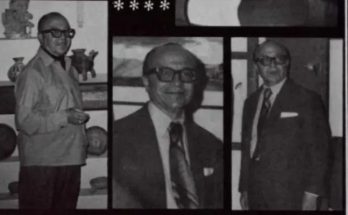By Luis Felipe Rodriguez
On December 12, 1970, the facilities of the Guadalupano Orphanage of Mexiquito, as we know them today, were inaugurated. Father José Mojica said that he and his mother, Virginia, used to watch the sunsets from the old town of Mexiquito. One afternoon while contemplating the ruins of the town Doña Virginia suggested that he should try to build a church there to honor the Virgin of Guadalupe.
“Son, San Miguel has a lot of Catholicism and a large number of churches,” she told him, “but I don’t know of any dedicated to Our Blessed Mother of Guadalupe. It is a pity that the hacienda is in such a state of abandonment. It could be used to build a church for the Guadalupana.” Mojica replied “I promise you, mother, that one day I will have a church built for Our Mother of Guadalupe.”
There is no documentation on exactly when the idea of building this church came up. According to Mother Teresa Calderón, of the Dominicas de María order, it was Father José Mercadillo, parish priest of San Miguel de Allende, whose idea it was. Father Mercadillo had been a close friend of José Mojica ever since the latter moved to San Miguel. The two probably discussed the project.
In his book on José Mojica, Father Federico Richter makes one of the first mentions of Mexiquito. He says that in April 1957, “We took the opportunity to visit the place [Mexiquito] where Father Mojica planned to build a Guadalupano shrine to honor the Blessed Virgin Mary and to educate and care for orphaned children in this area. The owners of the Hacienda of Mexiquito were the Romero Erazo brothers…who said that they wanted to donate their property for the stated purpose.”
Mojica immediately began the project by organizing a committee to raise funds. According to Mother Teresa Calderón, the idea of the home came later, when there was a need for more space for the boy orphans. At that time they lived at the girls’ Don Bosco Orphanage on calle Sollano in Centro, and were cared for by the Dominican Sisters of Maria.
Father Alfaro had created a nunnery, but in 1859, almost 100 years after its founding, it was affected by Benito Juárez’s anti-clerical laws. Subsequently, the religious persecution of 1926 meant the closure of all religious retreats, and all religious worship was suspended. The nunnery became a barracks and warehouse. In 1943, Father Mercadillo reopened the retreat and resumed religious activities there. The number of attendees increased yearly, reaching up to 8,000. Mercadillo decided to reestablish a nunnery to attend to preparing food for the priests and seminarians, care for the sick, and teach catechism to the children. These women looked after the church and sacristy, among other domestic chores.
Mercadillo enlisted six young women, and put María Padilla in charge. However, he eventually wanted nuns to run the nunnery, and Mother Teresa joined the order in 1955. They took in children who roamed the street, almost naked and full of lice. One girl, named Antonia, had fled Mexico City, where she lived with her mother who beat her. Eventually there were too many children, so Father Mercadillo founded the Don Bosco Orphanage for girls on February 18, 1959. Because it was felt that the boys should be separated from the girls, the idea arose of founding the home in Mexiquito.
Currently, the Santuario Hogar Guadalupano de Mexiquito is run by the Dominican Sisters of Mary. Aside from orphanages, the sisters work in mission centers, preach, and teach catechism. They also run sanctuaries, retreat houses, parishes, seminaries, and religious formation houses. The sisters provide social assistance, nursing, accounting, catechism education, liturgy, music, and singing.




